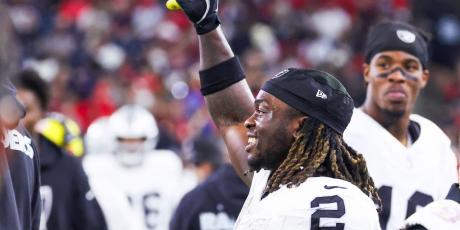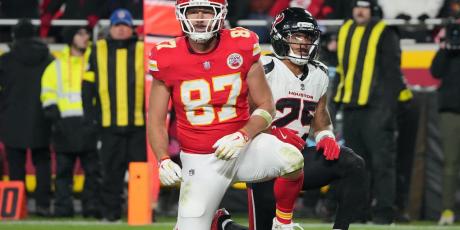The 4for4 Fantasy Football Injury Index: How Do Injuries Affect Player Performance?

Injuries suck. It is my main job to break down and discuss NFL injuries. Without them, I would not have a job here at 4for4, and even I can agree - injuries suck. But in a sport like football, they are bound to happen, and as a result, we must discuss them.
If we are being honest, aside from the player’s long-term health, when it comes to their team, all fantasy managers care about is:
- How long will it take for a player to return from injury?
- How will they look when they return?
That is what the focus of this specific article is. Below I have provided you with objective information for you to use regarding injuries in the NFL. The data is from 2017-2021. It contains injury timelines and fantasy performance specifically for quarterbacks, running backs, wide receivers, and tight ends. Altogether there are nearly 1,200 injuries that are included in this data set.
Before you read any further, I think it is important to lay some ground rules, so there is no confusion. I am not saying that this is exactly what will happen when a player returns following an injury. The numbers below are averages from players since 2017 (5-year sample). Like most things in life, context is important. Every injury is unique. However, understanding trends can help you make more informed decisions when it comes to setting your lineup each week.
Questionable vs. Doubtful
Per the NFL rules, when a player is listed as “Questionable” (Q) they are “uncertain” if that player will play that week, while the “Doubtful” (D) tag means it is “unlikely” a player will be available. In short, questionable should mean that a player is truly 50/50 that week and doubtful implies the chances are slim.
Obviously, teams are not always forthcoming when listing players as questionable or doubtful. Some teams are a little more liberal with these labels. However, I wanted to look at the percentages a player played each week when they were listed as either Questionable or Doubtful on the last injury report of the week. In most cases, being labeled with either at the end of the week should be a true indication of an injury.
Questionable Tag
- 71.1% of players played
- 28.9% of players did not play
Doubtful Tag
- 94.3% of players did not play
- 5.7% of players played
Clearly, when a player is listed as doubtful the Friday leading up to the Sunday/Monday slate of games, the odds are overwhelming that they are not going to play. On the positive side, when looking at QBs, WRs, RBs, and TEs since 2017 (1048 sample size), there is above a 70% chance that a player plays that week.
Fantasy Production
How do players perform when they are dealing with an injury that week, and is there a difference if the player is listed as Questionable or Doubtful?
|
Injury Tag
|
Fantasy Production (%)
|
|---|---|
|
Questionable or Doubtful
|
-18.6
|
|
Questionable
|
-18.6
|
|
Doubtful
|
-16.9**
|
**Players listed as doubtful saw a smaller dip in production the sample of players listed as doubtful (108) that actually played was diluted to just 5.
Although the players in the Doubtful pool saw a smaller decrease in production, the sample here is very small. Compared to their "Healthy Average" (fantasy points per game when not injured), players saw an ~18% dip in fantasy production the week they were listed as Q or D.
Positional Breakdown
Subsetting the data further, we can see how each position performed when they were on the injury report (listed as Q or D heading into the week). Despite being at the forefront of the offense, it would appear that quarterbacks are least affected by injury, as their fantasy production saw the smallest decline when on the injury report. It’s possible that the positional demands of running backs, wide receivers and tight ends make it difficult to perform up to standards.
|
Position
|
Fantasy Production (%)
|
|---|---|
|
QB
|
-8.1
|
|
RB
|
-15.7
|
|
WR
|
-22.2
|
|
TE
|
-17.6
|
How Each Position Performs Based On Different Injuries
Digging a little bit deeper, I wanted to see how different injuries affected a player's fantasy production. For example, high ankle sprains are notoriously bad for running backs; however, inversion ankle sprains do not typically damper a player's performance afterward.
Additionally, I wanted to analyze how different positions might be affected based on the injury. While a shoulder injury might be minor for a wide receiver, it's likely to significantly impact quarterbacks' production. Before we take a look, here is some background information on the data.
The tables below are broken down by:
- Player position
- Type of injury
Additionally, it looks at weeks missed (instead of just games missed to account for bye weeks).
Re-Injury Rate is the instance where a player sustained an injury, returned from the injury, and later missed time again due to the same injury.
Fantasy production (Fantasy Prod.) was based on how a player performed the first week following the injury compared to their “Healthy Average” (Fantasy points per game when not injured). It included instances where a player did or did not miss time with.
To gauge how more serious injuries affected performance, an additional section was included that just examined fantasy production when the player missed at least one week with injury - “Fantasy Prod. 1WM.”
Where appropriate and when the sample size was sufficient a three-game average post-injury to account for lingering issues. The label created for this was “Fantasy Prod. 3W Avg.”
When the sample was not large enough to portray an accurate picture, "NA" was set as a placeholder.
Now that I have explained the methodology behind all of this, the breakdown of the data is below.
Quarterbacks
Below are the 11 most common injuries charted for quarterbacks since 2017. Where appropriate, some injuries were broken down into more specifics.
|
Injury
|
Avg. Weeks Missed
|
Re-Injury Rate (%)
|
Fantasy Prod. Change 1W +/- (%)
|
Fantasy Prod. Change 1WM +/- (%)
|
Fantasy Prod. Change 3W Avg. +/-(%)
|
|---|---|---|---|---|---|
|
foot (nonspecific)
|
4.0
|
NA
|
10.1
|
14.0
|
NA
|
|
inversion ankle sprain
|
3.71
|
0.0
|
8.4
|
NA
|
NA
|
|
high ankle sprain
|
4.4
|
NA
|
NA
|
NA
|
NA
|
|
calf strain
|
1.5
|
0.0
|
-16.0
|
-16.0
|
-2.8
|
|
knee (nonspecific)
|
3.6
|
9.1
|
15.6
|
15.6
|
NA
|
|
hamstring strain
|
1.8
|
20.0
|
-36.2
|
-39.1
|
-5.2
|
|
hip (nonspecific)
|
2.3
|
0.0
|
NA
|
NA
|
NA
|
|
elbow (nonspecific)
|
4.3
|
0.0
|
NA
|
NA
|
NA
|
|
shoulder (nonspecific)
|
2.8
|
20.0
|
-15.5
|
-18.7
|
-5.9
|
|
back (nonspecific)
|
1
|
0.0
|
-38.9
|
NA
|
NA
|
|
rib injury
|
2.8
|
0.0
|
37.3
|
53.4
|
36.0
|
|
concussion
|
0.9
|
0.0
|
6.9
|
33.0
|
19.8
|
* Key: 1) Fantasy Production Change 1W = fantasy points the first week post-injury compared to healthy average. 2) Fantasy Production Change 1WM = fantasy post-injury when a player missed at least one week with an injury. 3) Fantasy Production Change 3W Avg. = average fantasy points the first 3 weeks post-injury once a player returns.
Summary:
- Overall, Quarterback play was not significantly dampened by injury.
- The two injuries resulting in the most time missed were elbow injuries (uhh, off Matthew Stafford managers) and high ankle sprains.
- Back injuries resulted in the most substantial dip in fantasy production immediately following injury, but if a QB missed at least one game (suggesting a more serious injury), hamstring strains could also be quite detrimental.
Running Backs
Below are the 15 most common injuries charted for running backs since 2017. Where appropriate, some injuries were broken down into more specifics.
|
Injury
|
Avg. Weeks Missed
|
Re-Injury Rate (%)
|
Fantasy Prod. Change 1W +/- (%)
|
Fantasy Prod. Change 1WM +/- (%)
|
Fantasy Prod. Change 3W Avg. +/- (%)
|
|---|---|---|---|---|---|
|
foot (nonspecific)
|
4.2
|
11.1
|
-24.4
|
-26.8
|
-25.1
|
|
turf toe
|
2.9
|
0.0
|
-12.6
|
-12.6
|
14.3
|
|
inversion ankle sprain
|
1.7
|
11.5
|
-5.4
|
-15.0
|
-13.2
|
|
high ankle sprain
|
3.1
|
4.3
|
-22.3
|
-22.3
|
-21.7
|
|
calf strain
|
2.3
|
0.0
|
-35.9
|
-45.5
|
-41.1
|
|
knee (nonspecific)
|
2.9
|
8.8
|
-21.9
|
-23.4
|
-17.7
|
|
MCL sprain
|
3.3
|
0.0
|
-8.9
|
-8.9
|
-17.5
|
|
hamstring strain
|
3
|
14.3
|
-24.9
|
-22.7
|
-4.5
|
|
quadriceps strain
|
1.7
|
8.3
|
-27.3
|
-26.6
|
-5.4
|
|
groin strain
|
2.3
|
0.0
|
NA
|
NA
|
NA
|
|
hip (nonspecific)
|
1.8
|
7.1
|
-19.4
|
NA
|
NA
|
|
rib injury
|
2.1 |
10
|
-16.6
|
-28.6
|
5.1
|
|
shoulder (nonspecific)
|
1.7
|
10
|
-14.6
|
-17.7
|
-18.9
|
|
AC joint sprain
|
2.8
|
22.2
|
NA
|
NA
|
NA
|
|
concussion
|
1.8
|
0.0
|
-14.2
|
-10.2
|
-6.2
|
* Key: 1) Fantasy Production Change 1W = fantasy points the first week post-injury compared to healthy average. 2) Fantasy Production Change 1WM = fantasy post-injury when player missed at least one week with injury. 3) Fantasy Production Change 3W Avg. = average fantasy points the first 3 weeks post-injury once a player returns.
Summary:
- Historically the two most common injuries for NFL running backs are hamstring strains and AC joint sprains - therefore, it is not a coincidence that the data showed these two had by far the highest re-injury rates.
- Foot injuries result in the most missed time. The length of time to recover likely explains why fantasy production for RBs was also significantly impacted 3 games post-injury (Fantasy Prod. 3W Avg.).
- Calf strains also negatively impacted fantasy production and lingered as well.
- It's very difficult for RBs to return to form following a high ankle sprain. The data here shows how fantasy production is affected during the rest of the season (ROS) following a high ankle sprain compared to pre-high ankle sprain production.
|
Length of Absence
|
ROS Fantasy Production Change +/- (%)
|
|---|---|
|
0-8 Weeks (n=38)
|
-13.7
|
|
At least 1 Week Missed (n=34)
|
-20.7
|
*n denotes sample size
- Soft tissue injuries like hamstring strains and quadriceps strains impacted performance right after, but the data indicates it does not linger long term.
- Although turf toe is often viewed as a terrible injury for RBs, compared to other injuries, the impact was small.
Wide Receivers
Below are the 16 most common injuries charted for wide receivers since 2017. Where appropriate, some injuries were broken down into more specifics.
| Injury | Avg. Weeks Missed | Re-Injury Rate (%) | Fantasy Prod. Change 1W +/- (%) | Fantasy Prod. Change 1WM +/- (%) | Fantasy Prod. Change 3W Avg. +/- (%) |
|---|---|---|---|---|---|
| foot (nonspecific) | 3.7 | 16.7 | -13.4 | -27.7 | -24.1 |
| turf toe | 3.6 | 11.1 | 2.4 | 2.4 | 4.1 |
| ankle sprain (nonspecific) | 3.2 | 12.1 | -12.6 | -15.9 | -10.1 |
| high ankle sprain | 5.2 | 15.0 | -16.5 | -16.5 | 11.4 |
| calf strain | 1.8 | 18.1 | -33.1 | -36.9 | -14.1 |
| knee (nonspecific) | 2.0 | 12.1 | -20.6 | -15.5 | -18.3 |
| MCL sprain | 3.1 | 10.0 | -25.8 | -25.8 | -23.8 |
| hamstring strain | 2.6 | 15.2 | -18.8 | -17.8 | 0.7 |
| quadriceps strain | 2.5 | 15.0 | -15.3 | -28.7 | 0.5 |
| groin strain | 2.0 | 17.4 | -28.7 | -35.8 | -14.8 |
| hip (nonspecific) | 1.5 | 0.0 | 4.3 | -1.8 | -9.7 |
| core/abdomen | 5.1 | 9.1 | NA | NA | NA |
| back (nonspecific) | 1.0 | 0.0 | -25.1 | -15.9 | -16.5 |
| shoulder (nonspecific) | 3.8 | 8.9 | -9.3 | -10.2 | 11.0 |
| AC joint sprain | 3.8 | 28.6 | -23.3 | NA | NA |
| concussion | 1.7 | 8.1 | -23.2 | -31.7 | -10.7 |
Summary:
- Of all the players there was by far the most injuries collected by position were WRs (572).
- Hamstring injuries are by far the most common among WRs, followed by ankle injuries.
- Core and high ankle sprains resulted in the most time missed by a while. If an injury is severe, a WR could miss half the season with this type of injury.
- Calf strains resulted in the biggest dip in production the week following the injury; however, MCL sprains had the most resulted in the largest drop-off when a 3-game average was collected.
- Like with running backs, the effects of turf toe were minimal, while hip injuries and shoulder injuries did not seem to hurt WR fantasy point totals.
Tight Ends
Below are the 12 most common injuries charted for tight ends since 2017. Where appropriate, some injuries were broken down into more specifics.
| Injury | Avg. Weeks Missed | Re-Injury Rate (%) | Fantasy Prod. Change 1W +/- (%) | Fantasy Prod. Change 1WM +/- (%) | Fantasy Prod. Change 3W Avg. +/- (%) |
|---|---|---|---|---|---|
| inversion ankle sprain | 2.6 | 8.7 | -31.0 | -36.9 | -11.9 |
| high ankle sprain | 4.8 | 0.0 | NA | NA | NA |
| calf strain | 1.8 | 0.0 | -33.1 | -33.9 | NA |
| knee (nonspecific) | 2.2 | 5.7 | -35.6 | -44.4 | -4.6 |
| MCL sprain | 3.8 | 0.0 | -54.0 | -54.0 | -16.8 |
| hamstring strain | 2.6 | 7.7 | -38.1 | -38.5 | 7.6 |
| groin strain | 1.9 | 0.0 | -14.8 | -13.7 | NA |
| hip (nonspecific) | 3.0 | 0.0 | -24.7 | -22.0 | NA |
| back (nonspecific) | 3.3 | 13.3 | -35.5 | -22.3 | -13.8 |
| shoulder (nonspecific) | 1.1 | 6.3 | -2.7 | -2.3 | NA |
| neck (nonspecific) | 2.8 | 0.0 | NA | NA | NA |
| concussion | 2.8 | 0.0 | -15.4 | -15.9 | 6.1 |
Summary:
- There was not enough data accurately representing fantasy production following an injury for many of the TE categories.
- MCL sprain and back injuries caused TEs to miss the most amount of time. Many MCL sprains were season-ending for TEs.
- Additionally, MCL sprains decreased TE point totals the most, followed by hamstring strains, backs and calf strains.
- Shoulder injuries and groin strains had quicker recovery times amongst TEs.

















